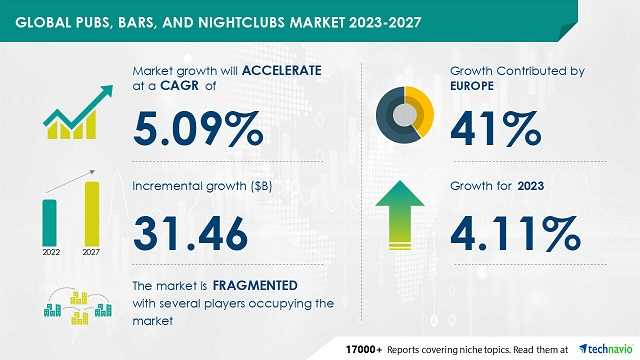NEW YORK, USA – According to the “Pubs, Bars, and Nightclubs Market by Product, Application, and Geography – Forecast and Analysis 2023-2027” report by Technavio, the pubs, bars, and nightclubs market is estimated to grow by USD 31.46 billion between 2022 and 2027 at a CAGR of 5.09%.
Europe will account for 41% of the market growth during the forecast period. The growth of the regional market is driven by the presence of many restaurant chains and high consumer expenditure in leisure activities.
In addition, the increasing popularity of wine among the older population and the rising demand for lager, flavored lager, and craft beer types are contributing to the growth of the pubs, bars, and nightclubs market in Europe
Vendor Landscape
The pubs, bars, and nightclubs market is fragmented due to the presence of numerous small and large vendors. All these players compete to meet the needs of consumers and to increase their market reach.
The heterogeneous nature of this industry has led to vendors intensely competing against each other based on quality, pricing, service, and menu variations. The current market includes companies of varying sizes.
The market faces competition from an unrelated segment, such as fine dining restaurants and local mobile and street vendors.
Market dynamics for pubs, bars, nightclubs
Major Driver – The market is driven by the increasing number of pubs and bars. Socialization at bars and restaurants is a growing trend among urban youth. Over recent years, the urban population has increased significantly. This can be attributed to the increased urbanization rate in developed countries such as the US, Canada, and European countries. The rate of urbanization is also increasing in developing countries in APAC. Changing tastes and preferences for different types of premium beverages among the urban population have increased the number of pubs and bars that offer alcoholic and nonalcoholic beverages. In addition, increased investments in infrastructure development projects such as airports and expressways are contributing to the growth of the market.
Key Trend – The rise in premium products is identified as the key trend in the market. Changes in drinking habits have encouraged consumers to prefer mixing their own cocktails. They are exhibiting increased demand for high-quality cocktails and beverages. Also, consumers are willing to spend more and purchase premium spirits and ingredients. To capitalize on this trend, vendors are changing their menus and adding cocktail lists that feature local, sustainable, or top-shelf spirits. They are also using illustrative drink descriptions on the menu. All these factors are expected to positively influence the market growth over the forecast period.
Major Challenge – Threats from the rising popularity of home-cooked food and takeaway services will challenge the growth of the market. Many people are increasing their preference for home-cooked food than eating at bars and pubs. The growing awareness about healthy eating habits and the risk of lifestyle-borne diseases like heart problems, diabetes, and obesity have led consumers to prefer home-cooked food. Home-cooked food is more nutritious, hygienic, and economical than dining out or takeaway foods. This shift in the eating habits among consumers will negatively affect the market growth.
















